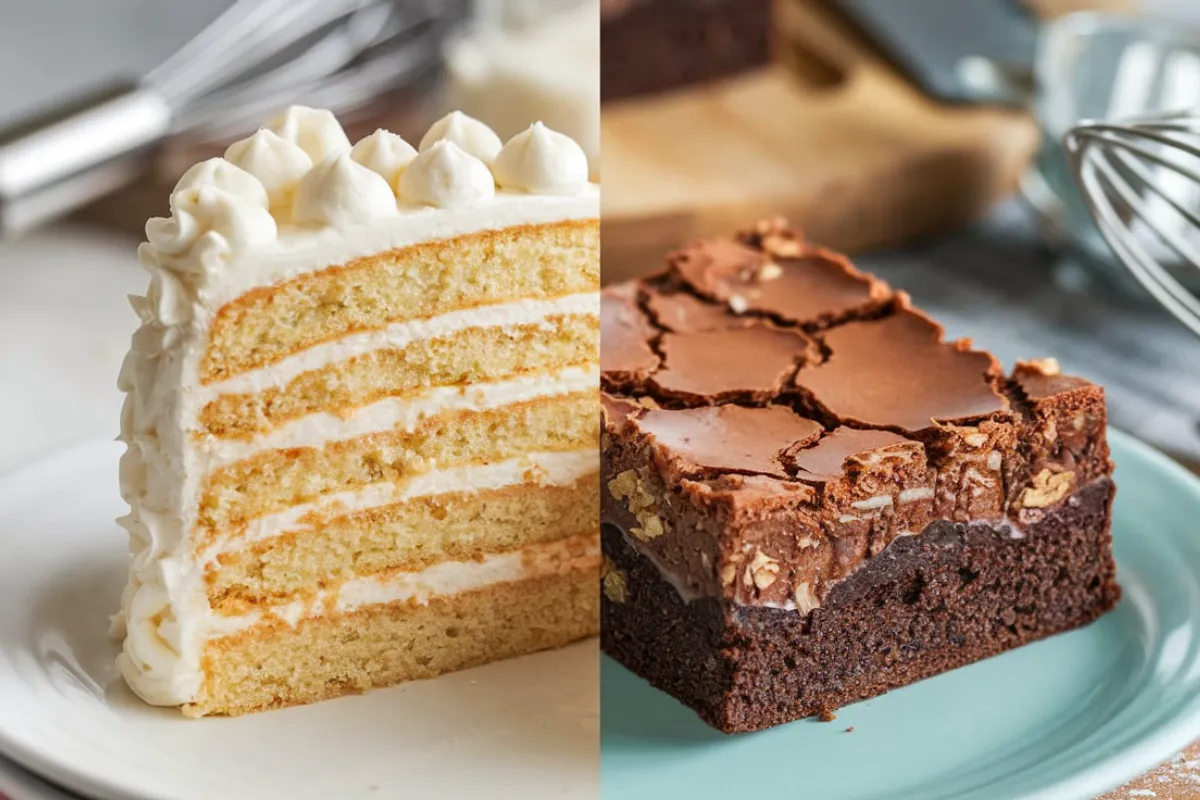Have you ever wondered what’s the difference between a cake and a brownie? Although these two treats share similar ingredients, their textures, ingredients, and preparation methods set them apart. In this article, we’ll explore the key differences and what makes each dessert unique.
Texture Differences Between Cake and Brownies
The texture is one of the most noticeable differences between a cake and a brownie.
- Cake Texture: Cakes are soft, fluffy, and light. The airy texture comes from the incorporation of leavening agents such as baking powder or baking soda, which helps the batter rise and create a spongy structure.
- Brownie Texture: Brownies are dense and chewy, with a slightly crispy top layer. This is due to the minimal use of leavening agents, which keeps the batter compact. Brownies also tend to have a rich, fudgy texture, especially when made with more chocolate or butter.
For a more in-depth look at the distinctive textures of brownies, check out this Brownie Texture Guide that dives into what makes brownies chewy or fudgy.
Key Ingredient Differences: Flour, Fat, and Sugar
The ingredients used in cakes and brownies may overlap, but their proportions vary significantly:
- Flour: Cakes typically use more flour to give structure and help the cake rise. Brownies, on the other hand, use less flour to maintain their dense and chewy texture.
- Fat: Brownies contain more fat, like butter or oil, than cakes. This gives brownies a richer and more decadent feel, while cakes are lighter due to the lower fat content.
- Sugar: The sugar content in brownies is often higher relative to the amount of flour, contributing to the gooey, fudgy texture. Cakes, on the other hand, have a more balanced sugar-to-flour ratio.
Want to experiment with different brownie textures? Try making a variation like the Ultimate Banana Brownie Recipe to combine unique flavors and textures.
Role of Leavening Agents in Cakes and Brownies
The use of leavening agents like baking powder or baking soda is crucial in determining whether your baked good will be light and airy or dense and chewy.
- Cakes: Leavening agents are a must for cakes. These ingredients create tiny air pockets in the batter, making the cake rise and giving it that spongy, fluffy consistency.
- Brownies: Brownies usually don’t rely on leavening agents as much. A small amount might be used in cakey brownie recipes, but traditional brownies omit them to keep the batter dense and fudgy.
For more insight into why some brownies turn out like cakes, take a look at this guide on Why Do My Brownies Turn into Cake?.
Preparation Techniques: Cakes vs. Brownies
Preparation techniques also play a crucial role in determining whether you’re baking a cake or a brownie.
- Cakes: Cakes are typically prepared using the creaming method, where butter and sugar are beaten together to incorporate air, making the batter lighter. Eggs are then added one at a time, followed by the dry ingredients.
- Brownies: Brownies often begin by melting butter and chocolate together. This gives the batter a rich, cohesive texture. Unlike cakes, brownie batter is mixed only until the ingredients are just combined, which helps keep the texture dense.
If you’re interested in blending cake and brownie elements, the Ultimate Brownie Cake Recipe is a perfect combination of the two desserts.
Baking Temperature and Time: Cake vs. Brownies
How long you bake a cake or brownie and at what temperature also determines the final result.
- Cakes: Cakes are usually baked at higher temperatures, such as 350°F, and for a longer time. This ensures the batter rises properly and creates a light, spongy texture.
- Brownies: Brownies are baked at lower temperatures, often around 325°F, for a shorter time. This helps preserve their moisture and prevents them from becoming overbaked and dry.
Variations of Cakes and Brownies
Both cakes and brownies come in various forms, each with its unique twist.
- Cakes: Some popular variations of cakes include sponge cake, chocolate cake, red velvet, and pound cake. Each cake type has its own balance of ingredients to achieve its signature texture.
- Brownies: Brownies also have multiple variations. You can make fudgy brownies, cakey brownies, or chewy brownies, depending on how much flour, fat, and sugar you use.
Serving Styles and Occasions
Cakes and brownies are often served in different ways and for different occasions.
- Cakes: Cakes are typically used for formal events like birthdays, weddings, or special celebrations. They are often layered and frosted.
- Brownies: Brownies are more casual and are commonly served as snacks or desserts. They are usually cut into squares and can be topped with frosting, nuts, or even ice cream.
For a detailed guide on frosting brownies, check out Do You Frost Brownies When They Are Warm?.
FAQs: Common Questions About Cake and Brownie Differences
- What makes brownies fudgy instead of cakey?
Fudginess is achieved by using a higher ratio of fat to flour, and by minimizing the use of leavening agents. A lower baking temperature also helps retain moisture. - Can brownies be considered a type of cake?
While brownies share some similarities with cake, their dense, chewy texture and lack of extensive rising agents make them a distinct dessert. - Why do brownies sometimes turn out like cake?
If your brownies have too much flour or leavening agent, they can become cakey. Adjusting these ingredients can keep them dense and fudgy. - How can I make brownies more like cake?
To create cakey brownies, increase the amount of flour and add a little baking powder or baking soda to give the batter more rise.
Conclusion: The Key Differences Between Cakes and Brownies
Cakes and brownies might share some ingredients, but their differences in texture, ingredients, and preparation methods make them stand apart. Cakes are known for their light, airy texture, while brownies are dense, chewy, and often fudgy. By understanding these key differences, you’ll be able to perfect both desserts for any occasion.
For more tips on creating the perfect brownie, check out What Makes Brownies Cakey vs. Fudgy?.

